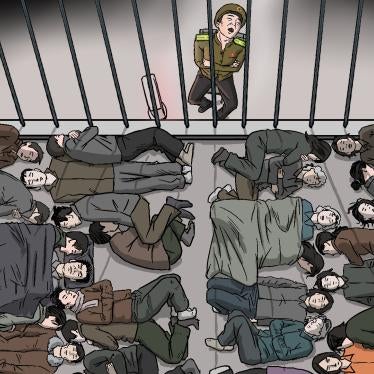On Dec. 3, 2010, antidrug police in Muntinlupa City arrested 30-year-old tricycle driver Ronaldo Rivera on drug trafficking charges. During his first court hearing three months later, Rivera said police produced 0.02 grams—equivalent to 10 grains of salt—of shabu.
That was the last time Rivera, who asserts his innocence, saw the inside of a courtroom. Instead, he has spent more than five years in detention at the Muntinlupa City Jail, unable under the drug laws to obtain bail or challenge the charges against him. Subsequent court proceedings have been repeatedly rescheduled or canceled by the court so many times that he said he has lost count.
Rivera’s plight is far from unique and is emblematic of a broken judicial system in which tens of thousands of people in the Philippines are detained for prolonged periods without either ever seeing a judge, or whose perfunctory court appearances stretch over years. According to the Bureau of Jail Management and Penology (BJMP), between 85 and 90 percent of the more than 94,000 inmates in its custody are awaiting or undergoing trial. This makes the Philippines the Southeast Asian country with the highest number of pretrial and remand detainees and the second highest in all of Asia. Prolonged detention without charge or trial violates international human rights instruments, including Article 9 of the International Covenant on Civil and Political Rights, which the Philippines ratified in 1986. Moreover, it “shall not be the general rule that persons awaiting trial shall be detained in custody,” but rather released with guarantees of appearing for trial.
The sources of this injustice are multifold: corrupt and incompetent investigators and prosecutors, a judicial and court system clogged with too many cases, and too few judges to try them. According to the Supreme Court, 26 percent of Philippine courts are vacant of judges. As a result, existing courts must share judges with other courts, resulting in extremely slow trial procedures. These institutional pathologies result in unjust and prolonged detention. Many detainees have been in jail longer than the maximum sentence for the offense with which they were charged, with some people spending as long as 14 years in detention before being convicted or released by the courts.
The injustice of lengthy detention is compounded by the horrific conditions of the jail facilities. Many detention centers in the Philippines fail to meet the minimum United Nations standards for such facilities, including inadequate amounts of food, poor nutrition, and unsanitary conditions. Torture and other forms of ill-treatment are also common. Because most of those who run afoul of the laws are poor, posting bail is often not an option. And even if they can afford bail, the majority of detainees in most of these jails face drug charges that are nonbailable.
These problems are made worse by critical and chronic overcrowding of jail facilities. The BJMP, which runs 415 detention facilities in 17 regions, said that on average, its jailhouses are 380 percent overcapacity. In Metro Manila alone, the BJMP’s total cell area of 22,318 square meters, which is designed for 4,749 detainees, currently holds 21,868 detainees, or a congestion rate of 361 percent. In another region, the rate is 720 percent.
The Commission on Human Rights (CHR), in a report published in April 2015, determined that overcrowding is the main concern in police lockup cells. This congestion is the primary source of mistreatment in these facilities. The CHR found that all of the 26 lockup cells it visited in several Metro Manila areas were overcrowded, some by nearly 300 percent of the intended capacity. Those conditions breed disease and tension among the detainees.
The lack of space frequently forces detainees to sleep while sitting, or even standing; some take turns sleeping. Bedding is so inadequate that many inmates sleep on discarded cardboard boxes or attach makeshift hammocks from the ceilings. These cells are also often dilapidated, with poor ventilation and absence of natural light; at least two cells at the Manila
Police District are in a basement and “are in a suffocating condition,” the CHR report said.
Sanitation in most of these cells is dire—toilet facilities “either do not exist or are poorly maintained,” the CHR said. In one cell, “a hole directly connected to the sewage” serves as a toilet while others are clogged, causing “odious stench.”
Detention facilities also lack adequate medical care for detainees, particularly pregnant women. In most Metro Manila lockup cells, prenatal services are nonexistent. Some cells do not provide medical attention at all to pregnant detainees. In several of the police cells in Quezon City and Manila that the CHR visited, not a single medical officer was available. The International Committee of the Red Cross has expressed concerns about health conditions in Philippine jails, particularly the spread of pulmonary illnesses such as tuberculosis, and skin infections, diarrhea, and sepsis.
The Philippine government has taken some initial steps to address these problems. Quezon City has piloted a program since 2013 designed to digitize court filings and proceedings. A justice-sector reform program funded by the European Union has been training police officers and investigators on investigation and case management procedures. The Public Attorney’s Office has added more lawyers to represent indigent suspects.
These initiatives show promise. But for them to make any meaningful impact on the thousands of Filipinos who waste years behind bars in pretrial detention or detention on remand, they need the government’s commitment and support to extend them nationwide. Until they do, the long wait for justice for detainees such as Rivera will continue.







